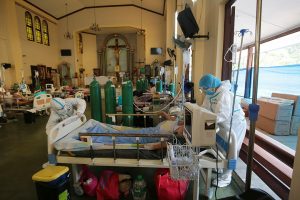INVESTMENTS in health infrastructure and preventive care need to be made before the next major public health emergency hits, the Asian Development Bank (ADB) said.
“Efforts to build a robust system should begin during normal times,” the ADB said in a report, “What has COVID-19 Taught Us About Asia’s Health Emergency Preparedness and Response?”
“This means building an established supply chain and health workforce with knowledge of disease transmission and vaccine delivery,” it added.
The ADB said many governments invested in testing laboratories, contact tracing, and quarantine facilities only during the pandemic and struggled to keep up with the surge in demand.
When the pandemic hit, governments resorted to lockdowns to curb the spread of the virus.
In the Philippines, which had one of the longest and strictest lockdowns, growth was set back, as was education.
The lockdown in the capital region exceeded the 76-day quarantine in Wuhan, the Chinese city where the first outbreak of the coronavirus was detected.
Philippine schools were closed between April 2020 and March 2022, one of the longest school closures in the world. The Philippines only resumed full face-to-face classes for public and private schools in November 2022.
Nine out of 10 Filipino children struggle to read and write simple text, the World Bank said in a 2021 report.
Unemployment also surged to an all-time high of 17.7% or around 7.3 million jobless, due to the lockdowns.
“Asian economies generally experienced relatively mild economic losses compared with the rest of the world, but they did not seem to recover from these losses any quicker,” the ADB said.
The report also noted that many governments relied on non-pharmaceutical interventions (NPIs), which stalled economic growth.
“While stringent NPIs have been associated with lower COVID-19 mortality rates, they also led to large economic contractions, reductions in psychological well-being, and substantial learning losses,” according to the report.
The Philippine economy contracted 9.5% in 2020, the steepest fall since 1947, according to the Philippine Statistics Authority.
The ADB also highlighted the need to bolster data infrastructure to aid government officials in their policy making.
“Governments should also rely on non-traditional data sources, including big data from the private sector and citizen-generated data,” it said.
Citing the cost of emergency preparedness, the ADB said local authorities must determine which emergencies are most likely to happen in their respective jurisdictions.
“Tailoring interventions for a specific economy, prioritizing pharmaceutical interventions in health emergencies, and integrating crisis response into macroeconomic policies are needed for an effective and context-specific response,” it said.
Doctor and public health consultant Raymond John Naguit said in an e-mail that the government’s “militarized responses to the pandemic exacerbated various inequities towards marginalized sectors.”
Over 100,000 individuals were arrested for allegedly violating quarantine protocols between March and September 2020.
Jose Rene D. de Grano, president of the Private Hospitals Association of the Philippines, Inc., said the health emergency response should be data and science driven.
“Government should always consult the medical experts and not rely on politicians who think more of how people will respond to their moves,” Mr. De Grano said in a Viber message.
Gene A. Nisperos, faculty member of the University of the Philippines College of Medicine, said the Philippines should address inadequate staffing of health facilities and strengthen the capacity of district hospitals and local health centers.
“We are still ill-equipped, because almost all of the problems exposed by the COVID pandemic remain unresolved,” he said via telephone.
Four years since the pandemic, Mr. Naguit said the Philippines has yet to “address issues related to building capacity of local health governments on health, create a robust and interoperable health information system that can guide policymaking, and address the long-standing issues of health workforce.” — Beatriz Marie D. Cruz
